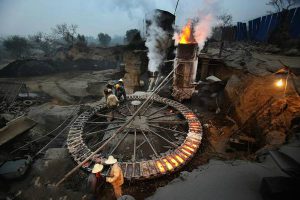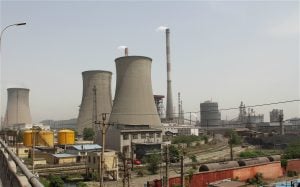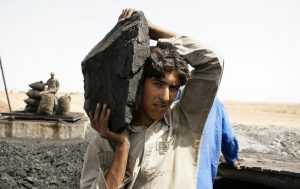Zhao Liang’s film Behemoth shines a light on the forces behind China’s rampant development and urbanisation.
The film’s images provide a striking impression of the environmental and health costs of coal mining and consumption, as well as the farcical nature of China’s property bubble. Behemoth was the only Asian documentary to be shown at the Venice International Film Festival in September last year, competing for the coveted Golden Lion prize.
Behemoth borrows its structure from Dante’s “Divine Comedy”, as a coal miner suffering from pneumoconiosis (a lung disease) guides the audience through a modern-day hell, purgatory and heaven – the coal mines and cities of Inner Mongolia.
(Zhao Liang has given chinadialogue permission to use this video clip. It cannot be republished on any other platform)
Speaking to the audience at a screening of the film, Zhao said he himself has seen the hell that Dante only imagined 800 years ago.
Zhao told the audience that the editing had been a “painful process.” There is no dialogue throughout the entire 90 minute film.
Zhao’s earlier critically acclaimed documentaries have shed light on some of the darkest corners of Chinese society – filming petitioners coming to Beijing and people living with HIV. But for a long time he has wanted to make an environmental documentary.
He was inspired to make Behemoth driving through Inner Mongolia, where grasslands scarred by mining reminded the filmmaker of craters on the moon and decided to stay in the province to film those other-worldly landscapes.
The production team was unable to film inside large state-owned mining companies, managing only to get a few shots of their operations. This forced them to focus on privately-owned mines – getting to know the bosses by drinking and chatting with them before getting permission to film. Sometimes they had to resort to recording their footage covertly.
The rapid expansion of cities has also transformed the region. In the film, ‘Paradise’ is the Inner Mongolian city of Ordos, China’s infamous “ghost city.” The scenes of the vast expanse of identical buildings – the result of excessive and unplanned property development – are unsettling. Official statistics estimate China has 700 million square metres of empty buildings, much of which can be demolished, according to one well-known property developer, since there is no demand for it.
‘Black lung’
The film also depicts the plight of coal miners – some of whom now suffer from pneumoconiosis, also known as ‘black lung’, a common hazard in the industry. Most mines do not sign contracts with the migrant workers they employ, and the disease develops slowly, by which time the coal pits have often closed or changed hands, so workers find it impossible to get compensation. Some miners are forced to petition the local government, standing outside their offices holding banners. Many of them now spend their lives trying to get damages for their illnesses – some of them dying before they do.
Originally, Zhao believed environmental issues affect the lives of everyone. But during filming he found that conflicting interests means solving environmental problems is no easy task.
Speaking at the film showing, famous art critic Li Xianting said that the film shows how “our pleasures are built on the suffering of others and the destruction of natural resources.”
Zhao hopes the film will make his audience think. “When an artist uses film to reflect something happening in society, to what extent does society change in response?” Zhao asked his audience.
Beijing has recently seen two air pollution red alerts, prompting another famous director, Jia Zhangke, to announce he will leave the city to escape the hazardous smog.
Zhao told chinadialogue that “the pollution does affect our quality of life and our feelings. I’m sick and tired of it.”
Zhao Liang is an award winning independent documentary film maker who exposes the fate of vulnerable social groups in China. He is director of the critically acclaimed 2009 film “Petition” and “Together” a film commissioned by the Ministry of Health about discrimination against people living with HIV/AIDS.
Feng Hao of chinadialogue also contributed to this article.








